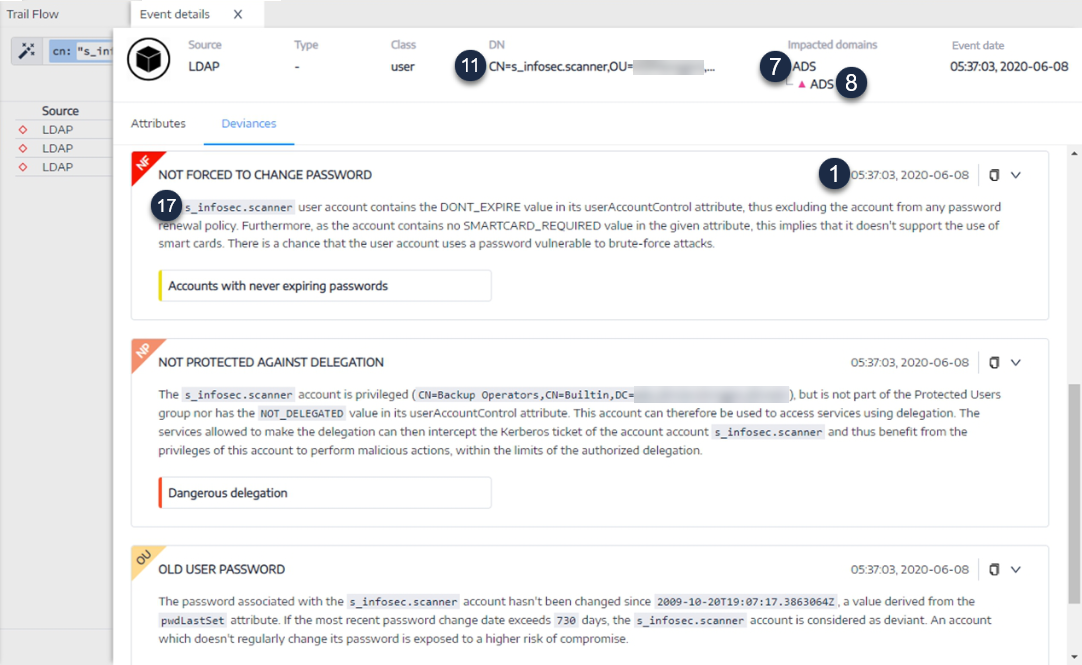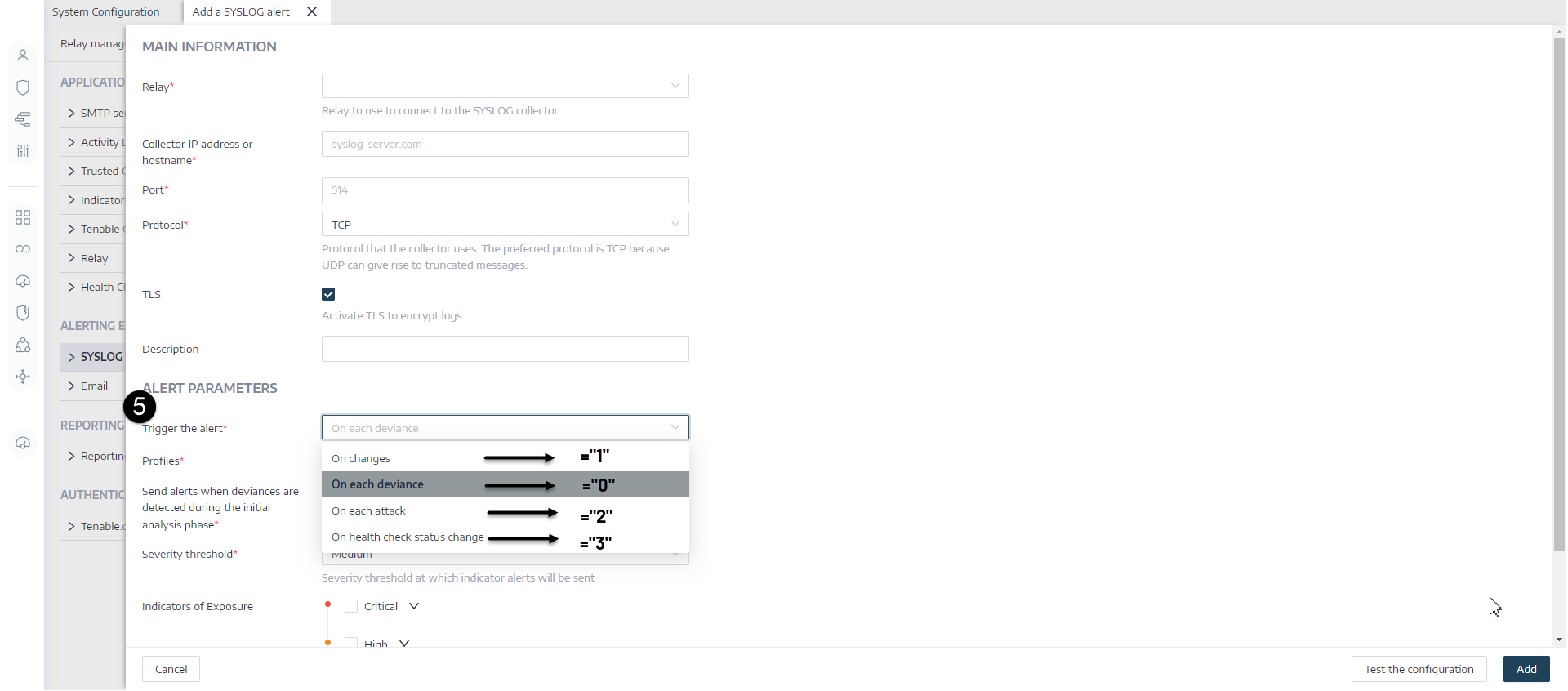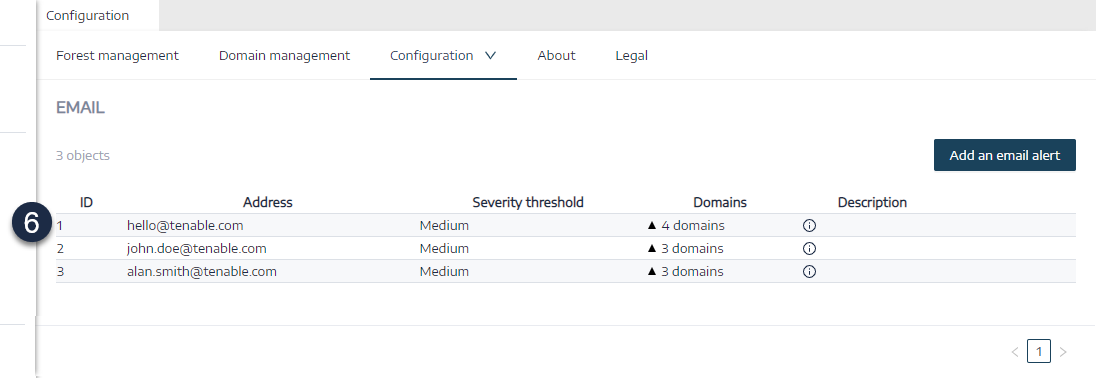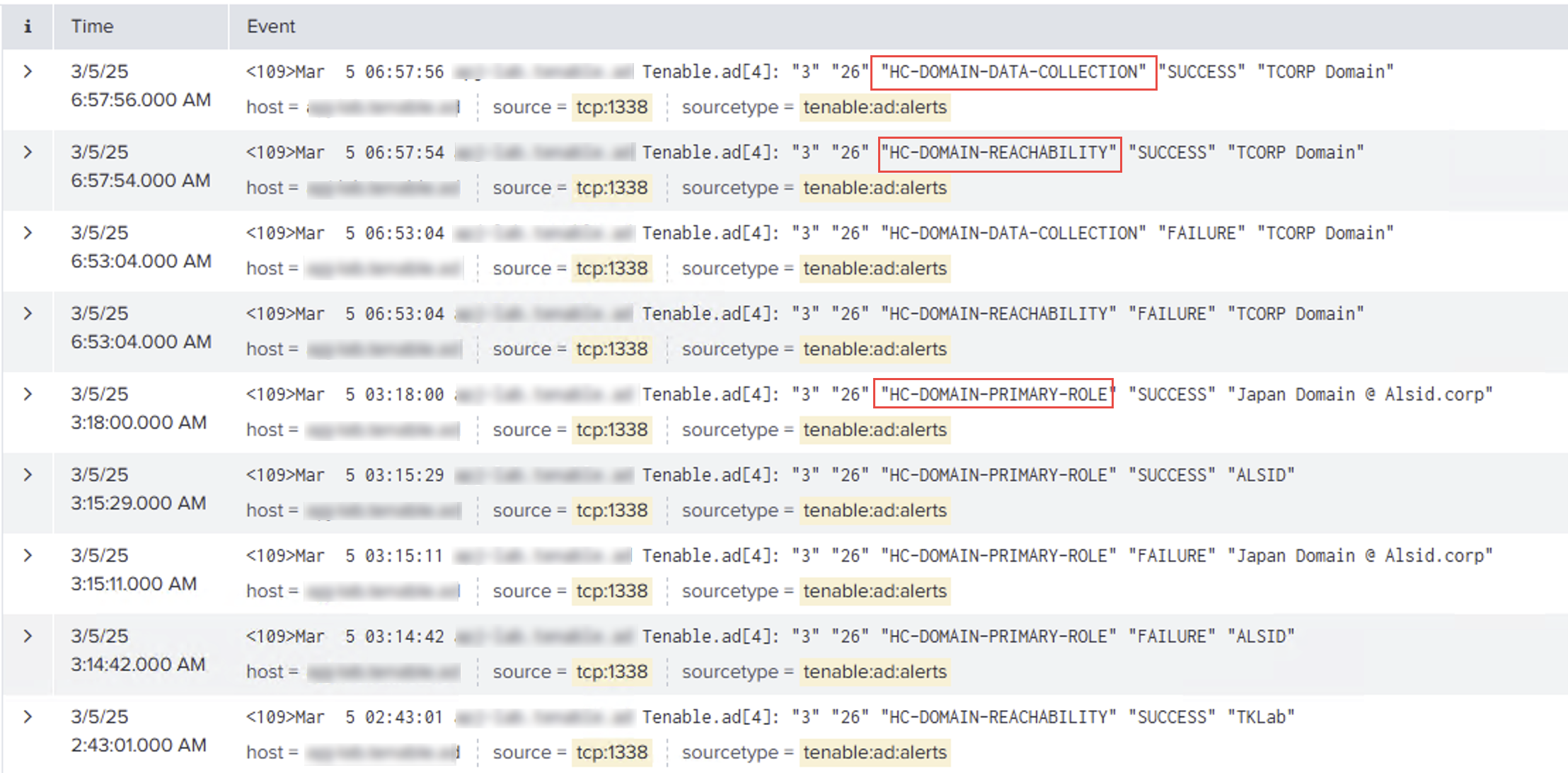Syslog and Email Alert Details
When you enable Syslog or email alerts, Tenable Identity Exposure sends out notifications when it detects a deviance, an attack, or a change.
Note: There is an ingestion time to consider before you receive IoA alerts. This delay is different from the timing observed during the "test the configuration" phase when you configure Syslog and email alerts. Hence, do not use the duration from the test configuration as a baseline to compare with the timing of alerts triggered by an actual attack.
Alert Header
Syslog alert headers (RFC-3164) use the Common Event Format (CEF), a common format in solutions that integrate Security Information and Event Management (SIEM).
Example of an alert for an Indicator of Exposure (IoE)
IoE Alert Header
<116>Jan 9 09:24:42 qradar.alsid.app AlsidForAD[4]: "0" "1" "Alsid Forest" "emea.corp" "C-PASSWORD-DONT-EXPIRE" "medium" "CN=Gustavo Fring,OU=Los_Pollos_Hermanos,OU=Emea,DC=emea,DC=corp" "28" "1" "R-DONT-EXPIRE-SET" "2434" "TrusteeCn"="Gustavo Fring"Example of an alert for an Indicator of Attack (IoA)
IoA Alert Header
<116>Jan 9 09:24:42 qradar.alsid.app AlsidForAD[4]: "2" "1337" "Alsid Forest" "emea.corp" "DC Sync" "medium" "yoda.alsid.corp" "10.0.0.1" "antoinex1x.alsid.corp" "10.1.0.1" "user"="Gustavo Fring" "dc_name"="MyDC"Alert Information
Generic Elements
The header structure includes the following parts, as described in the table.
| Part | Description |
|---|---|
| 1 |
Time Stamp— The date of the detection. Example: "Jun 7 05:37:03" |
| 2 |
Hostname — The hostname of your application. Example: "customer.tenable.ad" |
| 3 |
Product Name — The name of the product that triggered the deviance. Example: "TenableAD", "AnotherTenableADProduct" |
| 4 |
PID — The product (Tenable Identity Exposure) ID. Example: [4] |
| 5 |
Tenable Msg Type — The identifier of event sources. Example: "0" (= On each deviance), "1" (= On changes), "2" (= On each attack), "3" (=On health check status change) |
| 6 |
Tenable Alert ID — The unique ID of the alert. Example: "0", "132" |
| 7 |
Forest Name — The forest name of the related event. Example: "Corp Forest" |
| 8 |
Domain Name — The domain name related to the event. Example: "tenable.corp", "zwx.com" |
| 9 |
Tenable Codename — The code name of the Indicator of Exposure (IoE) or Indicator of Attack (IoA). Examples: "C-PASSWORD-DONT-EXPIRE", "DC Sync". |
| 10 |
Tenable Severity Level — The severity level of the related deviance. Example: "critical", "high", "medium" |
IoE Specific Elements
| Part | Description |
|---|---|
| 11 |
AD Object — The Distinguished Name of the deviant object. Example: "CN=s_infosec.scanner,OU=ADManagers,DC=domain,DC=local" |
| 12 |
Tenable Deviance ID — The ID of the deviance. Example: "24980", "132", "28" |
| 13 |
Tenable Profile ID — The ID of the profile on which Tenable Identity Exposure triggered the deviance. Example: "1" (Tenable), "2" (sec_team) |
| 14 |
AD Reason Codename — The code name of the deviance reason. Example: "R-DONT-EXPIRE-SET", "R-UNCONST-DELEG" |
| 15 |
Tenable Event ID — The ID of the event that the deviance triggered. Example: "40667", "28" |
| 16 |
Tenable Insertion Strings Name — The attribute name that the deviant object triggered. Example: "Cn", "useraccountcontrol", "member", "pwdlastset" |
| 17 |
Tenable Insertion Strings Value — The value of the attribute that the deviant object triggered. Example: "s_infosec.scanner", "CN=Backup Operators,CN=Builtin,DC=domain,DC=local" |
String Insertions and Double Quotes
|
|
IoA Specific Elements
| Part | Description |
|---|---|
| 11 |
Source hostname — The hostname of the attacking host. Value can also be "Unknown". |
| 12 |
Source IP Address — The IP address of the attacking host. Values can be IPv4 or IPv6. |
| 13 |
Destination Hostname — The hostname of the attacked host. |
| 14 |
Destination IP Address — The IP address of the attacked host. Values can be IPv4 or IPv6. |
| 15 |
Attack Vector Insertion Strings Name — The attribute name that the deviant object triggered. |
| 16 |
Attack Vector Insertion Strings Value — The value of the attribute that the deviant object triggered. |
Syslog Message Framing
-
For UDP and TCP syslog configuration, Tenable Identity Exposure uses Non-Transparent-Framing method as per RFC-6587#3.4.2 to delimit messages. The framing character is LF (\n).
-
For TCP with TLS, Tenable Identity Exposure uses Octet Counting method as described in RFC-6587#3.4.1.
Examples
This example shows the source for the event (5). You set this parameter in the Syslog configuration page. For more information, see Syslog Alerts.
This example shows the results for the health checks that Tenable Identity Exposure carried out in your environment. For more information, see Health Checks.

The header structure includes the following parts, as described in the table.
| Part | Description |
|---|---|
| 1 |
Time Stamp— Indicates the date and time when the event was detected. |
| 2 |
Syslog Priority — This is the syslog priority value, combining the facility and severity levels (RFC-3164) |
| 3 |
Hostname — The hostname of the application or device that generated the alert. |
| 4 |
Product Name and PID — Specifies the product name and its process ID. |
| 5 |
Tenable Msg Type — The identifier of event sources. Example: "0" (= On each deviance), "1" (= On changes), "2" (= On each attack), "3" (=On health check status change) |
| 6 |
Tenable Alert ID — The unique ID of the alert. Example: "0", "132" |
| 7 |
Health Check Codename — Denotes the specific health check performed. For more information, see Health Checks. |
| 8 |
Health Check Status — Indicates the outcome of the health check. |
| 9 |
Relay Name or Domain Name — Identifies the relay or domain controller associated with this health check. |
| 10-12 |
Metadata Fields:
|






